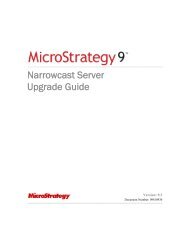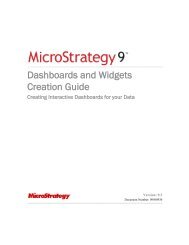MicroStrategy Mobile Design and Administration Guide
MicroStrategy Mobile Design and Administration Guide
MicroStrategy Mobile Design and Administration Guide
You also want an ePaper? Increase the reach of your titles
YUMPU automatically turns print PDFs into web optimized ePapers that Google loves.
<strong>Mobile</strong> <strong>Design</strong> <strong>and</strong> <strong>Administration</strong> <strong>Guide</strong> Administering <strong>MicroStrategy</strong> <strong>Mobile</strong> 3<br />
If you are not using an IT Policy, you can create a <strong>Mobile</strong> configuration from<br />
the <strong>Mobile</strong> Server Administrator page, or you can configure individual<br />
devices through the <strong>Mobile</strong> application’s Preferences screen. For instructions<br />
on creating a <strong>Mobile</strong> configuration, see Configuring the application from<br />
<strong>Mobile</strong> Server Administrator. For instructions on configuring an application<br />
manually, see Configuring the application from the BlackBerry device,<br />
page 174.<br />
Information needed to configure the application<br />
To retrieve report data from a <strong>Mobile</strong> Server, you must specify the following<br />
information about that server:<br />
• The server name<br />
• The port the server is running on<br />
• The path to the <strong>MicroStrategy</strong> <strong>Mobile</strong> application<br />
• The application type (ASP.NET for <strong>Mobile</strong>, or J2EE for <strong>Mobile</strong> Universal)<br />
• The authentication mode (anonymous, basic, or Windows) <strong>and</strong> login<br />
information used to access the server’s virtual directory<br />
• Whether the requests are sent as HTTP (unsecured) or HTTPS (secured)<br />
For more information about the difference between HTTP <strong>and</strong><br />
HTTPS, see SSL encryption, page 117.<br />
In addition, you must provide the following information for each project<br />
containing reports or documents to be viewed in <strong>Mobile</strong>:<br />
• The project’s name<br />
• The name of the Intelligence Server that hosts the project<br />
• The port number for that Intelligence Server<br />
• The authentication mode <strong>and</strong> login information used to access the<br />
reports or documents in the project<br />
By default, <strong>MicroStrategy</strong> <strong>Mobile</strong> uses st<strong>and</strong>ard <strong>MicroStrategy</strong><br />
authentication to identify the user logging in to projects on the <strong>MicroStrategy</strong><br />
<strong>Mobile</strong> Server. However, you can use any of the supported forms of<br />
authentication to log in to the server: st<strong>and</strong>ard authentication, Windows<br />
credentials, warehouse authentication, or LDAP authentication. For details<br />
about the different authentication modes, see the Setting up User Security<br />
chapter in the <strong>MicroStrategy</strong> System <strong>Administration</strong> <strong>Guide</strong>.<br />
© 2012 <strong>MicroStrategy</strong>, Inc. Deploying <strong>and</strong> configuring the <strong>MicroStrategy</strong> <strong>Mobile</strong> application 163



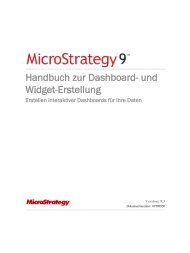

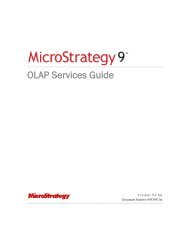
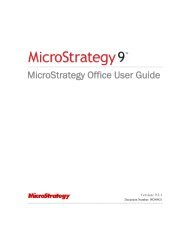
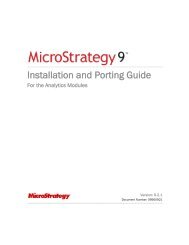


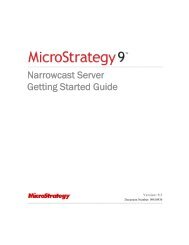

![The New Era of Mobile Intelligence: [PDF] - MicroStrategy](https://img.yumpu.com/13859921/1/190x245/the-new-era-of-mobile-intelligence-pdf-microstrategy.jpg?quality=85)
![customer success story [pdf] - MicroStrategy](https://img.yumpu.com/13859884/1/190x146/customer-success-story-pdf-microstrategy.jpg?quality=85)
![Call for Speakers Guide [PDF] - MicroStrategy](https://img.yumpu.com/13859856/1/190x245/call-for-speakers-guide-pdf-microstrategy.jpg?quality=85)
